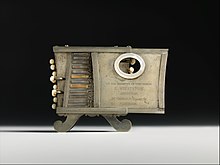Symphonium

The symphonium is a musical instrument patented by Charles Wheatstone (1802–1875) as a Wind Musical Instrument in 1829 . It can be regarded as a harmonica with keys and is considered to be the forerunner of the English concertina , also patented by Wheatstone in 1844 , in which the air is produced by a bellows . Somewhat later models of the symphonium already had the same key arrangement as the concertina.
Framework
Charles Wheatstone was part of wealthy London society. He only became a professor through his inventions. He was self-taught and very shy. Charles Wheatstone's company was already producing aeolines ( harmonicas without chambers ) in 1828 . Charles Wheatstone was first and foremost an inventor and researcher; even then, the execution was the responsibility of skilled craftsmen. Charles Wheatstone and his brother William Wheatstone had taken over the company of their uncle shortly before (1823) after the latter had died unexpectedly early. When the company took over in 1823, Charles 21 and William were approximately 18 years old. Charles Wheatstone had started an apprenticeship with his uncle, which he never finished because he was too unskilled. He preferred to study books and new inventions from France by buying fonts with his pocket money and then carrying out experiments. At that time he was particularly interested in the laws of acoustics . This led to the fact that he wrote a text in which he explained the basic harmonic relationships. Probably based on these principles, he also derived the key arrangement of the later symphonium and concertina. The Symphonium was described as an improvement on the Aeoline with keys, which at that time was already available from German production in London. A playing instruction for such an instrument, which was published in English, reports on it.
description
The symphonium was a small metal box with an oval mouthpiece. The drawing of the patent shows 16 keys arranged diatonic with an additional low tone. The tones ranged over two octaves . Slightly later models already had semitones according to the new system.
The buttons were arranged on either side of the box. The further development ultimately led to the English concertina. The tongues of the reed plates were made of gold or silver. Charles Wheatstone experimented with different alloys for the reeds, which in turn benefited other instrument makers. Ultimately, however, he used steel tongues in concertinas.
